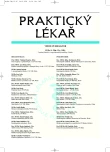Mammography for elderly women
Mamární screeening u starších žen
V České republice patří karcinom prsu k nejčastějším zhoubným novotvarům žen. Mamografie, společně se samovyšetřováním a klinickým vyšetřením, zlepšuje jeho detekci v časném stádiu, screening pomocí mamografie signifikantně snižuje mortalitu.
Autor prezentuje zkušenosti z realizace programu screeningu nádorů prsu v období r. 2002-2005, celkem u 19 115 vyšetřených žen, pojištěnek Hutnické zaměstnanecké pojišťovny (dále HZP) ve věku od 45-69 let. Analýzy, provedené revizním lékařem z dat informačního systému ve spolupráci se systémovým programátorem, prokázaly vzestupný trend účasti na mamárním screeningu, vykazování zdravotních výkonů a každoroční nárůst výše celkových úhrad. Nikoliv však významné nižší zastoupení starších žen v porovnání s mladšími věkovými skupinami. Podobně jako u dlouhodobého sledování účasti a provádění preventivních prohlídek byl také u screeningu potvrzen jak pokles v aktivní účasti, tak v informovanosti počínaje odchodem do starobního důchodu. Ve dvaceti dvou případech byl screeningovou mamografií prokázán zhoubný novotvar prsu a zároveň bylo možné určit stadium jeho pokročilosti. Poznatky z kontrol a analýz tak z pohledu dlouhodobé perspektivy mohou být reálnými podněty pro návrhy vedoucí k dalšímu zkvalitnění organizace screeningu nádorů prsu v ČR. Provádění preventivních prohlídek, účast na nich v průběhu celého života žen a realizaci mamárního screeningu podle nastavených pravidel v systému veřejného zdravotního pojištění, je v rámci sekundární prevence v primární péči nutné považovat neustále za dominantní.
Klíčová slova:
sekundární prevence, nádor prsu, screeningová mamografie, ženy staršího věku, kontrola, revizní lékař
Authors:
H. Dolanský
Authors‘ workplace:
Jeremenkova 11, Ostrava-Vítkovice
; Hutnická zaměstnanecká pojišťovna
Published in:
Prakt. Lék. 2006; 86(10): 578-582
Category:
Of different specialties
Overview
Breast carcinoma is one of the most frequent malignant neoplasms of women in the Czech Republic. Mammography, together with self-examination and clinical tests, has improved early detection and significantly reduced mortality.
The author presents experiences from one breast tumour screening programme, which, between 2002 and 2005, screened 19 115 women between the ages of 45 and 49 who were insured through HZP (Metallurgical employee’s insurance company).
Analysis of the data from the computer system by a physician in cooperation with a system’s programmer showed an increased interest in mammary screening and an annual rise in financial contributions from the public health insurance company. However, this trend for increased concern about mammography was not seen in elderly women.
As with other long-term studies into preventative checks-up, interest in mammography decreases upon retirement. A malignant neoplasm was detected by mammography in 22 cases–and its stage of malignancy recognised. In the long-term, information gathered from check-ups and analysis may help improve the quality of the screening service in the Czech Republic. Preventative checks-up and mammary screening throughout a woman’s life is considered extremely important for secondary prevention as part of primary care.
Keywords:
Secondary prevention, breast carcinoma, mammography, elderly women, check-up.
Labels
General practitioner for children and adolescents General practitioner for adultsArticle was published in
General Practitioner

2006 Issue 10
- Memantine Eases Daily Life for Patients and Caregivers
- Metamizole vs. Tramadol in Postoperative Analgesia
- Metamizole at a Glance and in Practice – Effective Non-Opioid Analgesic for All Ages
- Memantine in Dementia Therapy – Current Findings and Possible Future Applications
- What Effect Can Be Expected from Limosilactobacillus reuteri in Mucositis and Peri-Implantitis?
Most read in this issue
- Early repolarization: how could be misinterpreted as an acute coronary ischemia
- Penis size and female sexual satisfaction
- Gastroesophageal reflux disease – questions and answers, myths and facts
- Twenty four hour effectiveness of metoprolol tartrate in patients with newly diagnosed hypertension.
